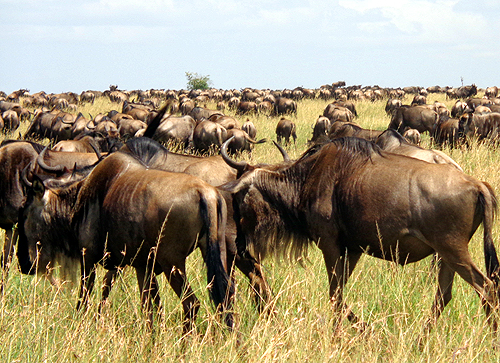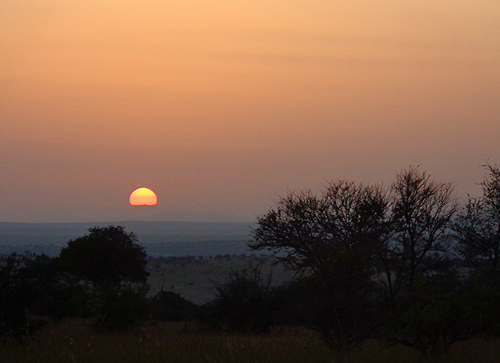 The Kisiel family’s last two days on safari featured the great migration at its best, including a croc feast of a wildebeest river crossing.
The Kisiel family’s last two days on safari featured the great migration at its best, including a croc feast of a wildebeest river crossing.
We expected to find the migration in the north, and we did. We flew from the central Serengeti into the far northern Serengeti landing virtually in sight of the Kenyan border. Although our lovely Kuria Hills tented lodge was a half hour south of here, we spent most of the time game viewing in the north.
Five minutes after we left the airstrip in the Mara Region of northern Tanzania we were skirting the south and west banks of the great Mara river. Crocs so big I call them “dinosaur crocs” were everywhere, waiting for one of the two meals they eat each year.
We saw one monster that John Kohnstamm said was 24 feet long. Close. But on that first day, no wildebeest near the river that we could find. So we headed south to camp through absolutely beautiful Mara grasslands and rolling hills.
That afternoon we saw our first oribi, not something many safaris see. It’s a gorgeous little, somewhat hyper antelope with large black face spots.
We also saw a number of wonderful birds in addition to the common headliners like the lilac breasted roller. Add the gorgeous cliff chat, rosy-breasted lark, perhaps a hundred red-cheeked cordon bleu among many others.
The next morning – the Kisiel Family’s last morning – we packed a picnic lunch and left before dawn.
We stopped on a ridge that looked north into Kenya and waited for the African sunrise. We had flushed out many square-tailed nightjars having listened to their woeful scream in the night. Then about ten minutes before dawn the omnipresent ring-necked dove began to fill the veld from horizon to horizon with its hypnotic song.
And then a few minutes before sunrise the whole veld exploded with bird song, and Africa’s giant sun peaked up blaring a perfect red-orange orb through the thick morning haze.

We traveled all the way past the southern Sand River border of Kenya and began searching along the Sand River. There we saw what will always be one of my most precious safari events.
We were driving somewhat hidden in the heavy bush at the top of the 15-foot embankment of the Sand River, which unlike the Mara, usually has an all sand bottom with good and copious amounts of water flowing under the sand.
But there has been so much rain that there were actual streams in the sand river bottom.
We came upon a lion pride eating a recently killed wildebeest. There were two lionesses with seven cubs in two different litters, plus a young and magnificent pridemaster, plus a slightly younger juvenile male that already was bigger than Mom and was sprouting a wonderful new mane.
What was specially interesting was the fighting that we watched between Mom and this juvenile male. She would not let him eat.
He could easily have whooped her, since he was bigger and stronger, but her motherly instincts knew it was time for him to be kicked out of the pride. Not too long before we had seen two other males about his age, sulking on an anthill starving as a ring of wildebeest surrounded them.
Young males don’t know how to hunt. They have to teach themselves, and if they don’t, they starve. It’s the reason there are more females in the overall lion population than males.
So the juvenile male that had somehow managed to stay with the pride was trying a new tact. But it wasn’t working.
Any move he’d make, even the slowest and most methodical attempt to raise his leg on the embankment to scoot away, and Mom would snarl and attack him. Finally, he slipped away.
We had seen in about twenty minutes what wildlife photographers take years to document.
But believe it or not, the best was yet to come.
Thinking we’d seen it all, sated with experiences, we began to head home along the river. Lo and behold there was a small group of wildebeest and zebra that looked like they were ready to cross the great Mara River.
And below them, to the right and left and side and bottom, were giant crocs waiting. They were steady in the water despite the strong current, or on the embankment, or on the island rocks, just waiting … waiting.
So… we did, too.
Roy Stockwell kept saying to the wilde across the river, “Come ‘on guys, the grass is much sweeter on this side!”
Whether it was Roy or not, they finally came, in a sudden leap from the bank followed by leaps across the great river.
The crocs moved in from every side. One dinosaur sailed straight for a calve and pulled it under and another on the other side took down a yearling.
Both started screaming and the mother of the calve turned around and jumped back in the river, literally pouncing on top of the croc, but it was no use. He took it under and she leaped exhausted back onto the shore.
The larger yearling drew many big crocs as they started vying among themselves for the feast.
Camden Reiss, like many many kids and adults as well, didn’t like what he saw. And it is a terrible moment, and yet when we as the real king of the beasts step back to let nature do her thing, we realize there are as many wonders as catastrophes.
“Can’t get better than this!” Grandpa shouted.
